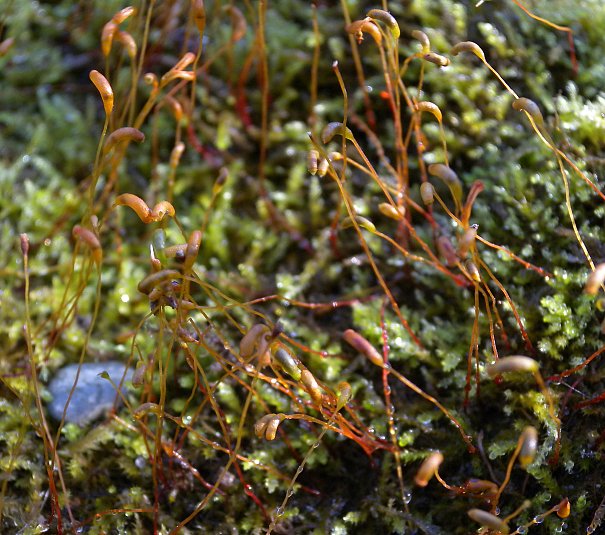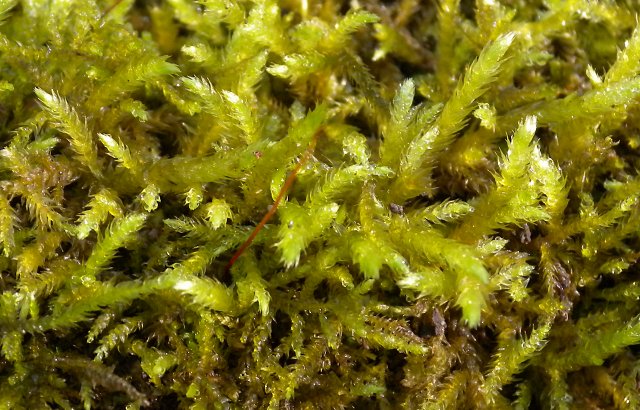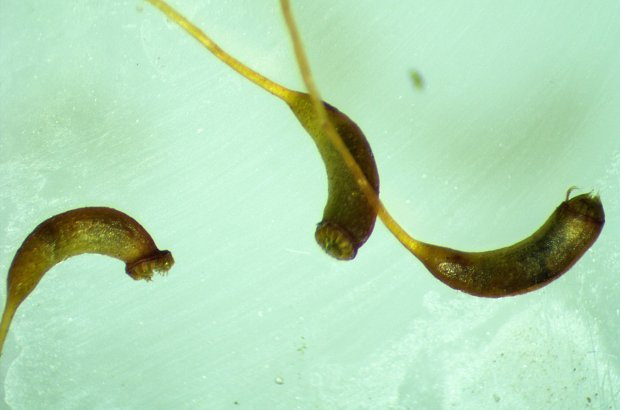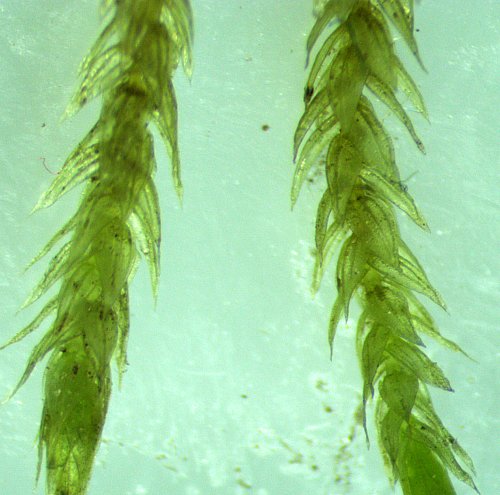
The cells of the leaves are narrow and elongated toward their tips, but they become more angular toward their bases. This moss is usually dioicous with separate male and female plants. During the spring, and possibly other times of the year, female plants produce sporophytes (spore-bearing capsules with stalks) at intervals along their stems. The slender stalks (setae) are 8-25 mm. long, ascending to erect, terete, hairless, smooth-textured, and reddish yellow, orange, or reddish brown when they become mature. The body of each spore-bearing capsule is 2-3 mm. long, arching-cylindrical in shape, and tapered at the base. The bodies of immature capsules are light green, but they soon become reddish yellow, orange, or reddish brown as they become more mature. The lids (opercula) of these capsules are conical in shape with nipple-like tips; they are late-deciduous. Both the lids and upper bodies of immature capsules are covered with beaked membranous hoods (calyptrae) that are early-deciduous. When the lid of a capsule falls off, a ring of incurved teeth is revealed. These teeth are linear-lanceolate in shape with bifurcated tips; they are yellow, orange, or red, but later become more brown like the capsules. Mature capsules are somewhat constricted below their ring of teeth.

The tiny spores are released during the late spring or summer (and possibly other times of the year); they are distributed by the wind. Individual spores are about 15 micrometers across, globoid in shape, and finely warty or bumpy (papillose). The stems of very young plants are anchored to the ground with fibrous rhizoids, but most stems of more mature plants lack rhizoids altogether. Clonal offsets of this moss are sometimes produced when the stems break away from the mother plant as a result of disturbance or the withering away of old stems.
Cultivation: The preference is light shade to partial sun, moist to dry-mesic conditions, and soil containing loam, clay-loam, or clay. This moss also adapts to rocky ground, moist rocks, rotting logs, and the bases of trees. It is rather common and weedy.

Range & Habitat: The native Pleated Foxtail Moss (Brachythecium laetum) is common throughout Illinois (see Distribution Map). It probably occurs in every county of the state. This moss is widely distributed in the eastern half of the United States and southern Canada. It also occurs in parts of southwestern United States and Mexico. Habitats include ground soil in woodlands, north-facing wooded slopes, ground soil in wooded bluffs, ground soil in open woodlands, ground soil in swampy woodlands, slopes of ravines in wooded areas, rotting logs in ravines and wooded areas, rotting logs in swamps, bases of old trees, shaded earthen banks, clay banks along streams and creeks, slopes along rivers, roadside embankments, shaded areas along roads, shaded damp areas along limestone and sandstone cliffs, moist rocks of algific limestone talus, borders of limestone sinks, moist rocks in ravines and wooded areas, cave walls near their entrances, abandoned limestone quarries, shaded rooftops of buildings, shrubby fallow fields, disturbed ground of cemeteries with groves of trees, disturbed ground in city parks, and disturbed areas of shaded lawns. The preceding wooded habitats are dominated by various deciduous trees, especially oak and maple. This moss is common in many disturbed areas, although it also occurs in high quality natural areas.

Faunal Associations: Many songbirds use this mat-forming moss in the construction of their nests. This includes the Barn Swallow, Carolina Wren, Catbird, Eastern Phoebe, American Robin, Least Flycatcher, Rufous-sided Towhee, and Slate-colored Junco (Breil & Moyle, 1976).
Photographic Location: A semi-shaded disturbed ground of Crystal Lake Park in Urbana, Illinois. Close-up photographs were taken with a microscope indoors.

Comments: Foxtail mosses (Brachythecium spp.) are difficult to distinguish from each other and their taxonomic history has been somewhat unstable. Following the guidance of efloras, this moss has been assigned the scientific name, Brachythecium laetum. Under this taxonomy, both Brachythecium oxycladon and Brachythecium digastrum are considered scientific synonyms of this species. Of these latter two names, Brachythecium oxycladon is still widely used as the scientific name of this moss. It is relatively easy to confuse this moss with another species that is common and weedy, Brachythecium salebrosum (Golden Foxtail Moss). This latter moss has leaves that are more narrow in shape (lanceolate-ovate to lanceolate) and slightly longer (2–2.5 mm. for leaves of primary stems, 1.5–2 mm. for leaves of secondary stems). The spore-bearing capsules of this moss are also slightly shorter in length (typically about 2 mm. in length). There are several other species of Foxtail Moss that occur in Illinois, but they are less common and more distinct in appearance. Another common name of Brachythecium laetum is Golden Foxtail Moss, although this name also refers to Brachythecium salebrosum. If it receives any exposure from the sun, Pleated Foxtail Moss (Brachythecium laetum) has attractive golden yellow foliage during the spring, but it has a tendency to fade away and turn brown during hot summer weather.